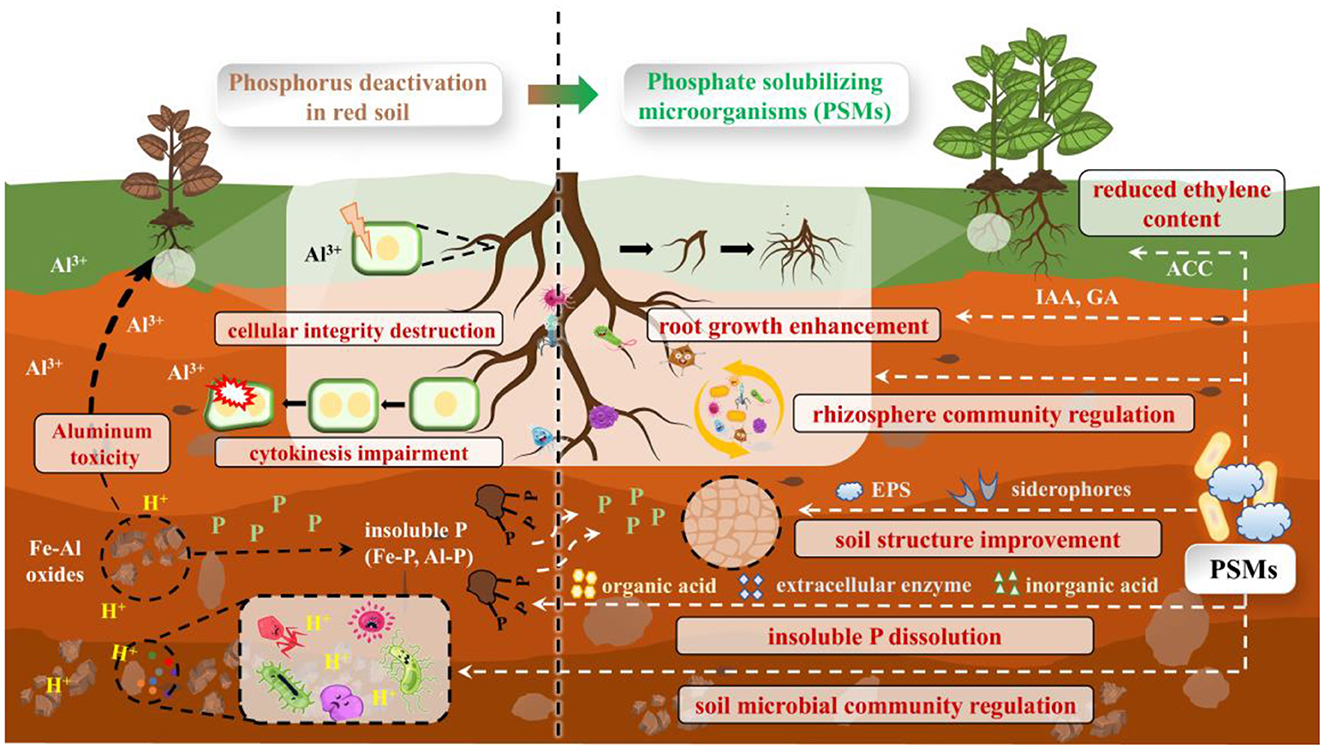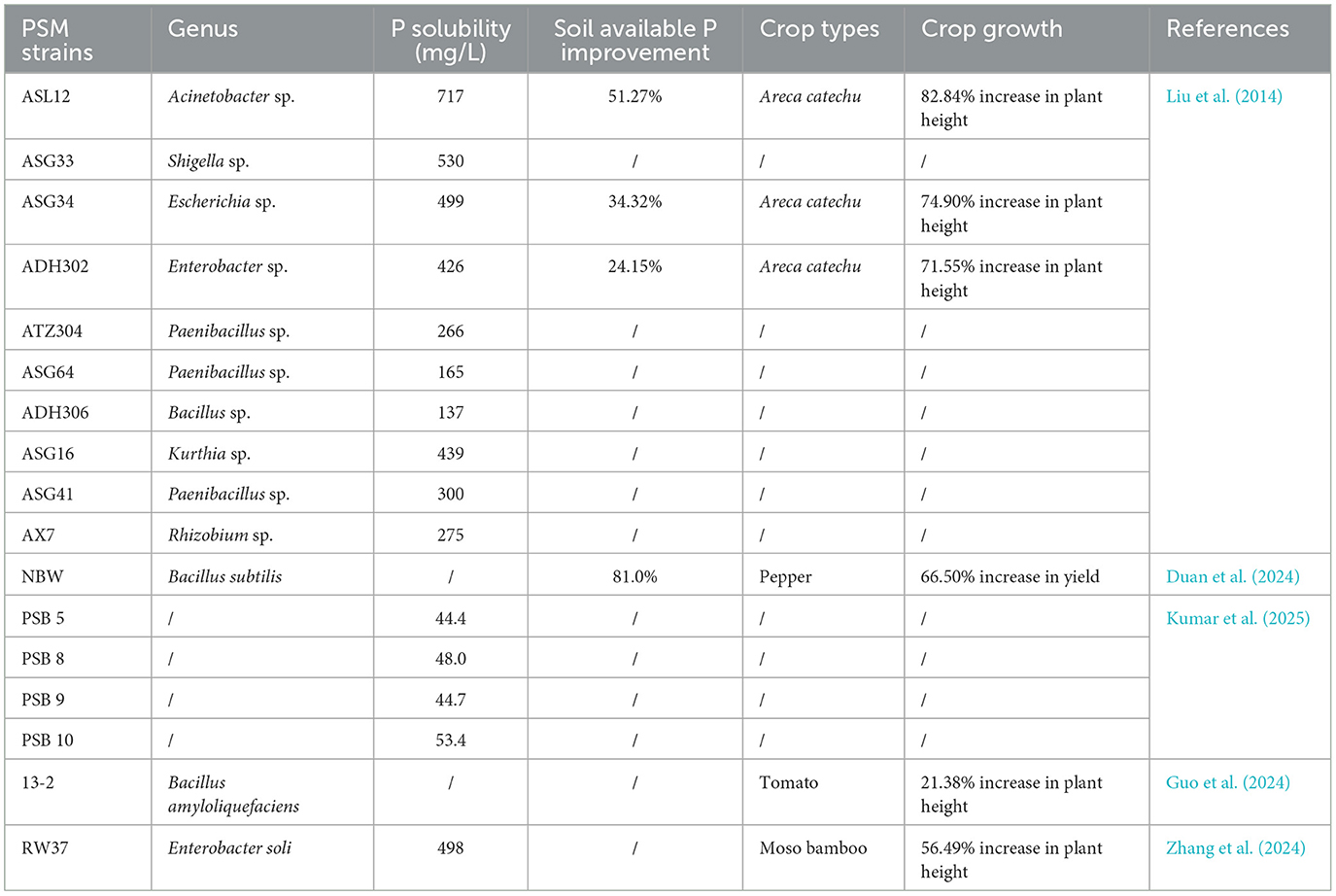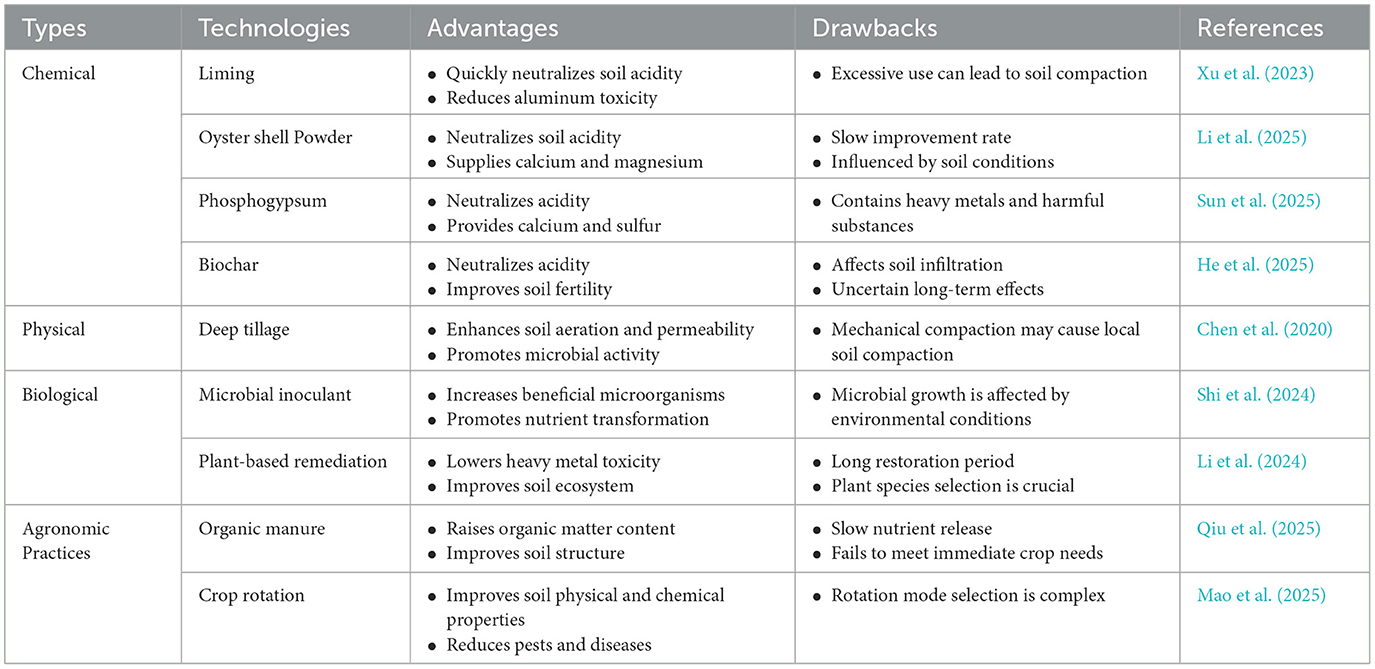- 1Tropical Crops Genetic Resources Institute, Chinese Academy of Tropical Agricultural Sciences, Haikou, Hainan, China
- 2School of Tropical Agriculture and Forestry, Hainan University, Haikou, China
1 Introduction
Tropical and subtropical agriculture is crucial for global food and economic crop production, and soil health directly impacts regional ecological security and food output. Red soils, widely distributed in these regions, are typical soil types formed by the long-term weathering of iron- and aluminum-rich oxides in hot and humid climates. Their red or brownish-red color results from the accumulation of iron and aluminum oxides. For instance, the red soil region in South China, covering 2.18 × 106 km2 (about 36% of China's arable land), is key for economic and food crop production (Lang et al., 2025; Huang and Zhao, 2014). However, due to their strong acidity, low base saturation, and high phosphorus (P) fixation capacity, red soils are among the most vulnerable soil types in agricultural production (Long et al., 2024).
P is essential for plant growth and development, driving cell division, differentiation, and metabolic processes (Ashley et al., 2011). While weathering of red soil parent material releases a significant amount of P, its bioavailability is constrained by the unique formation process of soil and mineral characteristics, resulting in a low flux biogeochemical cycle of P in red soil ecosystems (Ma et al., 2016). Under acidic conditions, secondary clay minerals and amorphous iron and aluminum oxides expose numerous hydroxyl sites, which adsorb phosphate ions specifically, forming stable inner-sphere complexes. Consequently, P is fixed in soil solids as amorphous or crystalline iron- and aluminum-phosphate (He et al., 2025). This chemical fixation is largely irreversible, creating a surplus of fixed P and significantly limiting the flux of available P in the soil-plant system (Huang et al., 2021). Moreover, the low organic matter content in red soils weakens the P coordination-dissolution balance. Soil aggregate destruction caused by intensive farming further exacerbates P leaching into deep soil layers (Huang et al., 2021). These factors, which cause P deactivation, severely restrict agricultural production in red soils. Critically, sustainable alternatives remain underexplored, particularly regarding microbiome-driven P activation. This review uniquely bridges microbial ecology with agronomic application, highlighting how phosphate-solubilizing microorganisms (PSMs) concurrently resolve P limitation, aluminum toxicity, and soil structural decline-gaps unaddressed by chemical approaches.
2 PSMs have unique potential in red soil improvement
2.1 Microbial technologies are widely used in red soil improvement
In the global context of sustainable agriculture, microbial technology, known for being eco-friendly and functionally diverse, has become a key research focus in red soil improvement. Traditional chemical methods, such as lime application and chemical phosphate fertilizer addition, can temporarily adjust soil acidity or supplement P (Table 1). However, their long-term use may lead to problems like secondary salinization, soil structure degradation, and increased ecological risks (Ji et al., 2024). In contrast, microbial technology can regulate soil biogeochemical cycles, thereby achieving multiple goals of nutrient activation, toxicity mitigation, and ecological restoration. Microbial metabolism directly acts on soil minerals and organic matter, releasing fixed nutrients and enhancing the soil microenvironment via metabolic products (Khan et al., 2024). Additionally, microbial growth promotes soil aggregate formation, thereby improving soil structure and boosting water and nutrient retention capacities (Long et al., 2025).
2.2 PSMs as potential candidates for red soil amelioration
PSMs are beneficial functional microorganisms that convert insoluble environmental phosphorus into plant-available forms. They were first identified in farmland and environmental studies (Vassilev et al., 2006). PSMs secrete acids and extracellular enzymes to dissolve insoluble inorganic and organic phosphates. Additionally, they release intracellular P through cell lysis, thereby enhancing soil P availability and improving soil microbial community balance (Hu and Chen, 2023). These characteristics provide PSMs with a unique advantage in red soil improvement. Notably, their ecological adaptability enables them to remain active under the extremely acidic conditions of red soils. For instance, studies have shown that Pseudomonas duriflava, Enterobacter quasimori, and Acinetobacter sp. exhibit robust phosphorus-solubilizing abilities at pH 4.5–6.2, indicating their genetic potential to adapt to red soil acidification (Kumar et al., 2025; Hidayat et al., 2024; Liu et al., 2014). Importantly, PSMs can maintain soil P availability over time, providing sustained nutrient support for crop growth, reducing reliance on external phosphate fertilizers, and thus aligning with the goals of red soil improvement and sustainable agriculture (Rawat et al., 2021).
3 PSMs regulate community structure to enhance red soil fertility via P activation
PSMs improve red soil fertility not only through their inherent functions but also by regulating the soil microbial community to form a synergistic ecological network (Figure 1). The decline in microbial diversity and functional imbalance caused by red soil acidification are key factors limiting nutrient cycling. Introduced PSMs can reshape the rhizosphere microbiome while modifying the local microenvironment. For example, they promote the colonization of beneficial bacteria, such as nitrogen-fixing bacteria, and boost the relative abundance of function microbes related to P cycling (Rawat et al., 2021). This community optimization builds a metabolic module centered on P activation, thereby strengthening the transformation efficiency of soil nutrients. Specifically, organic acids, inorganic acids, and enzymes secreted by PSMs can solubilize occluded P by protonating Fe-P and Al-P surfaces, thereby increasing available soil P and alleviating aluminum toxicity (Ahmad et al., 2023). Moreover, PSM metabolic products (e.g., exopolysaccharides, siderophores) stabilize soil aggregates, thereby improving pore structure and water-holding capacity and creating a favorable habitat for microbial activity (Khan et al., 2024).

Figure 1. Schematic diagram of phosphate-solubilizing microorganisms improving red soil and crop growth.
4 PSMs boost crop yield and stress resistance in red soils through multifaceted promotion
The effects of PSMs on red soil improvement and crop promotion are presented in Table 2. The growth-promoting effects of PSMs on red soil crops extend beyond mere nutrient supply. By multidimensionally regulating plant physiology, PSMs enhance crops' environmental adaptability, ensuring stable and increased yields under stress. Under red soil's strong acidity and aluminum toxicity, PSMs secrete plant hormones such as indoleacetic acid and gibberellins. These hormones stimulate root meristem activity, promoting lateral root and root hair development, thereby expanding nutrient absorption (Masrahi et al., 2023; Feng et al., 2024). Meanwhile, the ACC deaminase produced by PSMs degrades the ethylene precursor generated under plant stress, thereby alleviating root growth inhibition (Kumar et al., 2025). When confronting oxidative stress, PSMs activate the antioxidant enzyme system in crops (e.g., superoxide dismutase, peroxidase), scavenging excess reactive oxygen species and maintaining cell membrane stability (Rawat et al., 2021). Furthermore, the mutualistic relationship between PSMs and crop roots can induce systemic resistance in plants, thereby strengthening defense against soil-borne pathogens. For instance, combined amino acid and PSM applications have reduced pathogenic fungal relative abundance by 5.2%, thereby lowering disease risk (Shi et al., 2024). This mutualistic relationship involves complex signaling pathways and metabolic interactions. PSMs produce specific molecules that trigger plant defense responses, such as the production of pathogenesis-related proteins and secondary metabolites (Guo et al., 2024). In field practices, PSM applications consistently improve crop growth, foliar nitrogen and phosphorus concentrations, grain quality, and yields (Masrahi et al., 2023). This comprehensive regulation, ranging from soil improvement to enhancing crop stress resistance, highlights PSMs' central value in red soil agro-ecosystems.

Table 2. Phosphorus solubilizing capacity of PSMs and its effect on red soil improvement and crop growth.
5 Future research directions and strategies
PSMs activate soil P reserves, alleviate aluminum toxicity, and secrete growth promoters, representing a cost-effective and sustainable green strategy for red soil improvement. However, given some limitations of PSMs, future research can be further deepened in the following aspects: Firstly, targeting the extreme acidity of red soil, screening and engineering functional strains with efficient P solubilization and acid tolerance is crucial. Decoding the acid-resistant molecular mechanisms of PSMs via genomics and metabolomics, combined with gene editing to enhance their phosphorus-solubilizing capacity or aluminum detoxification pathways, can boost strain adaptability. Secondly, developing integrated restoration systems that combine multiple technologies is essential to overcome the limitations of single microbial technologies. For example, combining PSMs with biochar, phosphate minerals, and harmless phosphogypsum can provide microbial habitats and synergistically regulate soil pH. Additionally, it is necessary to comprehensively evaluate the long-term impacts of PSM application on the structure and functions of soil microbial communities. This can prevent potential imbalances or functional redundancies in indigenous microbial populations that may be caused by the introduction of exogenous microorganisms.
Author contributions
QM: Investigation, Writing – original draft. HC: Writing – review & editing. YY: Writing – original draft. BZ: Supervision, Writing – review & editing, Funding acquisition.
Funding
The author(s) declare that financial support was received for the research and/or publication of this article. This study was supported by the National Key Research and Development Program of China (2023YFD1901303) and Central Public Interest Scientific Institution Basal Research Fund (1630032023010, Tropical Crops Genetic Resources Institute, CATAS).
Conflict of interest
The authors declare that the research was conducted in the absence of any commercial or financial relationships that could be construed as a potential conflict of interest.
Generative AI statement
The author(s) declare that no Gen AI was used in the creation of this manuscript.
Publisher's note
All claims expressed in this article are solely those of the authors and do not necessarily represent those of their affiliated organizations, or those of the publisher, the editors and the reviewers. Any product that may be evaluated in this article, or claim that may be made by its manufacturer, is not guaranteed or endorsed by the publisher.
References
Ahmad, A., Moin, S. F., Liaqat, I., Saleem, S., Muhammad, F., Mujahid, T., and Zafar, U. (2023). Isolation, solubilization of inorganic phosphate, and production of organic acids by individual and co-inoculated microorganisms. Geomicrobiol. J. 40, 111–121. doi: 10.1080/01490451.2022.2124329
Ashley, K., Cordell, D., and Mavinic, D. (2011). A brief history of phosphorus: from the philosopher's stone to nutrient recovery and reuse. Chemosphere 84, 737–746. doi: 10.1016/j.chemosphere.2011.03.001
Chen, J., He, Y., and Li, P. (2020). Effects of tillage alteration on soil water content, maize crop water potential and grain yield under subtropical humid climate conditions. Int. Agrophys. 35, 1–9. doi: 10.31545/intagr/131668
Duan, Y., Li, D., Li, Z., Luo, J., Sun, X., Zhang, H., et al. (2024). Enhancing phosphorus bioavailability in lateritic red soil: Combining Bacillus subtilis inoculated microbial organic fertilizer with reduced chemical input. Soil Use Manage. 40:e12987. doi: 10.1111/sum.12987
Feng, Y., He, J., Zhang, H., Jia, X., Hu, Y., Ye, J., et al. (2024). Phosphate solubilizing microorganisms: a sustainability strategy to improve urban ecosystems. Front. Microbiol. 14:1320853. doi: 10.3389/fmicb.2023.1320853
Guo, Z., Lu, Z., Liu, Z., Zhou, W., Yang, S., Lv, J., and Wei, M. (2024). Difference in the effect of applying bacillus to control tomato verticillium wilt in black and red soil. Microorganisms 12:797. doi: 10.3390/microorganisms12040797
He, W., Zhang, J., Gao, W., Chen, Y., and Wei, Z. (2025). Enhancing phosphorus availability and dynamics in acidic soils through Rice straw biochar application: a sustainable alternative to chemical fertilizers. Front. Sustain. Food Syst. 9:1506609. doi: 10.3389/fsufs.2025.1506609
Hidayat, F., Pane, R. D. P., Sapalina, F., Listia, E., Lubis, M. E. S., Oshiro, M., et al. (2024). Novel multifunctional plant growth-promoting bacteria isolated from the oil palm rhizosphere under long-term organic matter application. J. Biosci. Bioeng. 138, 406–414. doi: 10.1016/j.jbiosc.2024.07.008
Hu, X., and Chen, H. (2023). Phosphate solubilizing microorganism: a green measure to effectively control and regulate heavy metal pollution in agricultural soils. Front. Microbiol. 14:1193670. doi: 10.3389/fmicb.2023.1193670
Huang, G. Q., and Zhao, Q. G. (2014). Initial exploration of red soil ecology. Acta Ecol. Sin 34, 5173–5181. doi: 10.5846/stxb201405100944
Huang, J., Zhou, L. H., Liu, S. J., Han, T. F., Hayatu, N. G., Li, D. C., et al. (2021). Vertical distribution of phosphorus fractions and the environmental critical phosphorus level in acidic red soil under long-term fertilizer and lime application in southern China. J. Plant Nutr. Soil Sci. 184, 585–595. doi: 10.1002/jpln.202100098
Ji, J. I., ZhenZhen, L. Ü., ShuZhen, L. I. U., HongQian, H. O. U., YiRen, L. I. U., XiuMei, L. I. U., et al. (2024). Long-term application of chemical fertilizers induces soil acidification and soil exchangeable base cation loss on paddy in Southern China. Scientia Agricultura Sinica 57, 2599–2611. doi: 10.3864/j.issn.0578-1752.2024.13.008
Khan, N., Siddiqui, M. H., Ahmad, S., Ahmad, M. M., and Siddiqui, S. (2024). New insights in enhancing the phosphorus use efficiency using phosphate-solubilizing microorganisms and their role in cropping system. Geomicrobiol. J. 41, 485–495. doi: 10.1080/01490451.2024.2331111
Kumar, A., Kumar, D., Arsey, S., Yadav, D. K., Gubre, D. F., Naroju, S. P., and Saini, P. (2025). Biochemical characterization and metabolic activities of salt tolerant phosphate solubilizing bacteria isolated from red soil. Cogent Food Agricult. 11:2472246. doi: 10.1080/23311932.2025.2472246
Lang, Y., Yang, X., and Cai, H. (2025). Depicting, spatializing, and decoupling the impact of human activities on soil erosion in the hilly red soil region of southern China from the perspective of soil erosion influence factors. J. Environ. Manage. 376:124371. doi: 10.1016/j.jenvman.2025.124371
Li, H., Wu, Y., Li, J., Han, T., Liu, K., and Huang, S. (2025). Long-term oyster shell powder applications increase crop yields and control soil acidity and cadmium in red soil drylands. Front. Plant Sci. 16:1506733. doi: 10.3389/fpls.2025.1506733
Li, W., Xie, L., Xu, Y., and Yang, M. (2024). Effect of mixed planting on soil nutrient availability and microbial diversity in the rhizosphere of Parashorea chinensis plantations. Front. Microbiol. 15:1464271. doi: 10.3389/fmicb.2024.1464271
Liu, F. P., Liu, H. Q., Zhou, H. L., Dong, Z. G., Bai, X. H., Bai, P., and Qiao, J. J. (2014). Isolation and characterization of phosphate-solubilizing bacteria from betel nut (Areca catechu) and their effects on plant growth and phosphorus mobilization in tropical soils. Biol. Fertil. Soils 50, 927–937. doi: 10.1007/s00374-014-0913-z
Long, C., Liu, Z., Liu, R., Yin, L., Tan, F., Wang, Y., and He, G. (2024). Soil microbial CO2 fixation rate disparities with different vegetation at a representative acidic red soil experimental station in China. Front. Microbiol. 15:1480484. doi: 10.3389/fmicb.2024.1480484
Long, X., Li, J., Liao, X., Zhang, W., Wang, K., and Zhao, J. (2025). Linking microbial metabolism and ecological strategies to soil carbon cycle function in agroecosystems. Soil Tillage Res. 251:106562. doi: 10.1016/j.still.2025.106562
Ma, J., He, P., Xu, X., He, W., Liu, Y., Yang, F., et al. (2016). Temporal and spatial changes in soil available phosphorus in China (1990–2012). Field Crops Res. 192, 13–20. doi: 10.1016/j.fcr.2016.04.006
Mao, H., Leng, K., Chen, X., Zhang, J., Liu, K., Lin, Y., et al. (2025). Changes in fertility and microbial communities of red soil and their contribution to crop yield following long-term different fertilization. J. Soils Sediments 25, 1115–1133. doi: 10.1007/s11368-025-03991-2
Masrahi, A. S., Alasmari, A., Shahin, M. G., Qumsani, A. T., Oraby, H. F., and Awad-Allah, M. M. (2023). Role of arbuscular mycorrhizal fungi and phosphate solubilizing bacteria in improving yield, yield components, and nutrients uptake of barley under salinity soil. Agriculture 13:537. doi: 10.3390/agriculture13030537
Qiu, H., Wen, S., Zhang, L., Xu, M., and Cai, Z. (2025). Total aluminum reduced but aluminum hydroxide increased in red soil of southern China after long-term swine manure amendment. Plant Soil 6, 1–9. doi: 10.1007/s11104-025-07492-6
Rawat, P., Das, S., Shankhdhar, D., and Shankhdhar, S. C. (2021). Phosphate-solubilizing microorganisms: mechanism and their role in phosphate solubilization and uptake. J. Soil Sci. Plant Nutr. 21, 49–68. doi: 10.1007/s42729-020-00342-7
Shi, W., Zhu, Y., Xing, Y., Wu, H., and Ying, Y. (2024). Enhancing phosphorus-solubilizing microorganism potential for alleviating plant phosphorus limitation through amino acid co-application. Appl. Soil Ecol. 204:105714. doi: 10.1016/j.apsoil.2024.105714
Sun, Y., Li, Z., Lin, X. C., Du, Q. R., Zou, X., and Zhang, X. (2025). Anti-disintegration property of red soil treated with building gypsum powder. Appl. Clay Sci. 273:107832. doi: 10.1016/j.clay.2025.107832
Vassilev, N., Vassileva, M., and Nikolaeva, I. (2006). Simultaneous P-solubilizing and biocontrol activity of microorganisms: potentials and future trends. Appl. Microbiol. Biotechnol. 71, 137–144. doi: 10.1007/s00253-006-0380-z
Xu, D., Zhu, Q., Ros, G. H., Xu, M., Wen, S., Zhang, F., and de Vries, W. (2023). Model-based optimal management strategies to mitigate soil acidification and minimize nutrient losses for croplands. Field Crops Res. 292:108827. doi: 10.1016/j.fcr.2023.108827
Keywords: microbial technology, red soil improvement, phosphorus inactivation, agricultural sustainability, tropical and subtropical agriculture
Citation: Ma Q, Chen H, Yang Y and Zhou B (2025) Unlocking phosphorus resources: phosphate-solubilizing microorganisms as a green strategy for activating phosphorus in acidic red soils and promoting crop growth. Front. Microbiol. 16:1630650. doi: 10.3389/fmicb.2025.1630650
Received: 18 May 2025; Accepted: 23 June 2025;
Published: 09 July 2025.
Edited by:
Abubakar Dar, The Islamia University of Bahawalpur, PakistanReviewed by:
Zahir Ahmad Zahir, University of Agriculture, Faisalabad, PakistanRubab Sarfraz, Gyeongsang National University, Republic of Korea
Copyright © 2025 Ma, Chen, Yang and Zhou. This is an open-access article distributed under the terms of the Creative Commons Attribution License (CC BY). The use, distribution or reproduction in other forums is permitted, provided the original author(s) and the copyright owner(s) are credited and that the original publication in this journal is cited, in accordance with accepted academic practice. No use, distribution or reproduction is permitted which does not comply with these terms.
*Correspondence: Bin Zhou, emhvdWJlYW5AdmlwLjE2My5jb20=
 Qingqing Ma
Qingqing Ma Huayi Chen
Huayi Chen Yuting Yang
Yuting Yang Bin Zhou
Bin Zhou